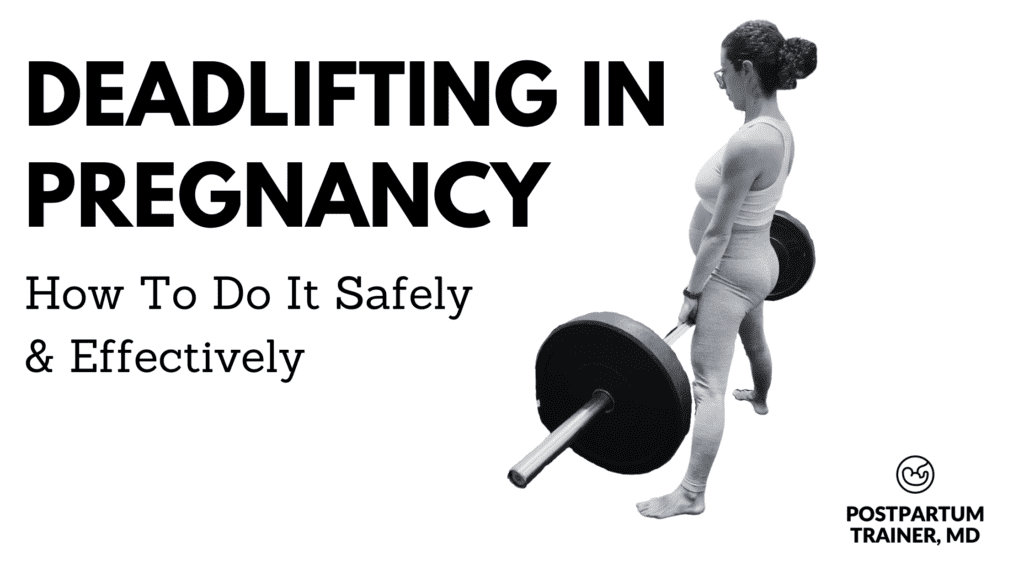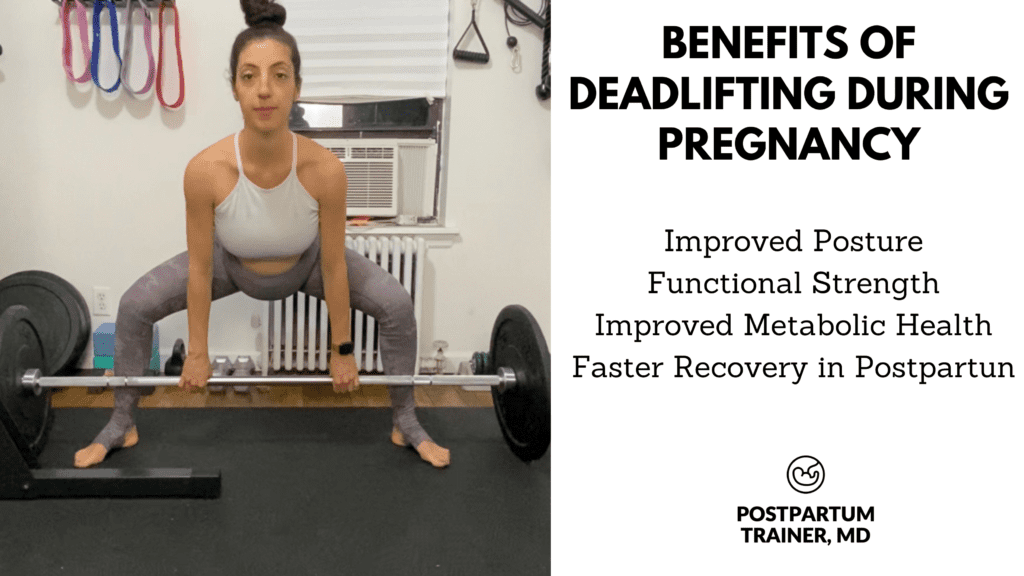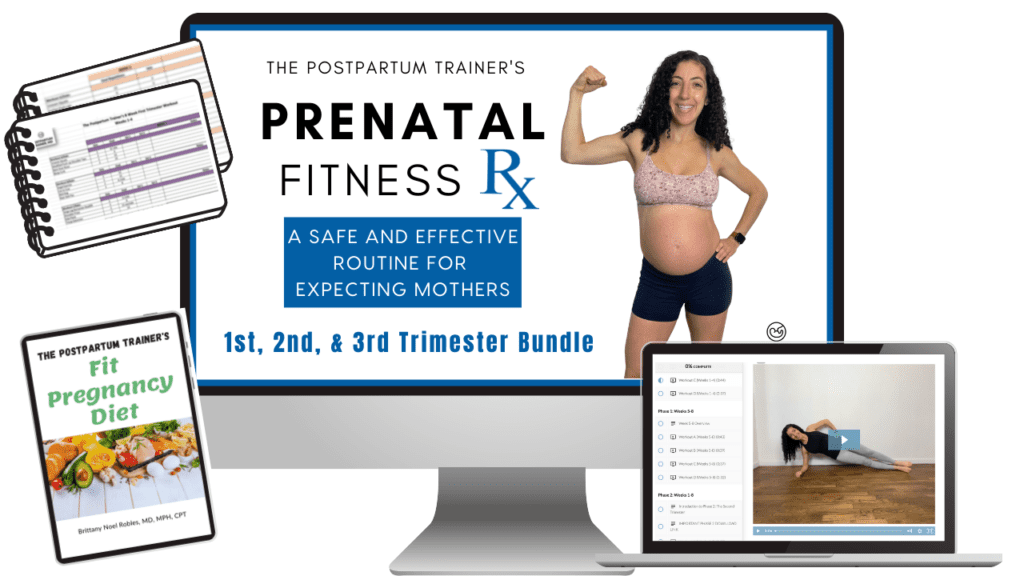Are you pregnant and wondering if you could still deadlift?
With a few pointers, you can deadlift safely and effectively throughout your pregnancy.
But first, you must speak with your healthcare provider or OBGYN to ensure you have no contraindications to working out.
Keep reading to learn:
- How to deadlift properly as your pregnancy progresses
- Safety considerations you need to be aware of, and
- Common mistakes and variations you should avoid
Let’s get started.

Is It Okay To Do Deadlifts While Pregnant?
Yes, it is okay to deadlift during pregnancy as long as you are medically cleared to exercise and are comfortable doing the movement.
With that said, it is essential that you start low and go slow. Avoid lifting heavy weights, and do not overexert yourself.
As your pregnancy progresses, you will likely have to modify the movement.
**Here is a video of me deadlifting throughout my pregnancy.**
Safety Considerations
When performing deadlifts during pregnancy, it is essential that you stay within your comfort zone.
You should only lift weights you feel comfortable with. Pregnancy is not a time to be setting personal records!
It is also a good idea to avoid doing the Valsalva maneuver (which is when you exhale without letting any air out). This maneuver can temporarily affect your heart rate and decrease blood flow to the baby.
Unfortunately, many people will Valsalva naturally when lifting heavy weights.
Instead, you should breathe using a regular and comfortable rhythm throughout the exercise.
Lastly, you must also be careful and mindful of the changes your body is going through.
Your uterus will grow drastically in the second and third trimesters, and you may need to make modifications to make the movement more comfortable.
You need to modify the movement if you cannot keep your spine in a neutral position or keep the weight close to your lower body.
What Is The Best Way To Execute A Deadlift While Pregnant?
The best way to execute a deadlift during pregnancy is to do the following:
- Approach a barbell on the ground with your feet shoulder-width apart and feet facing forward.
- Ensure that the bar is at the level of your mid-shin.
- Bend down and grab the bar with outstretched arms just outside of shoulder-width.
- Feel free to widen your stance if you have a baby bump.
- Keep your spine neutral and look forward.
- Before you start, engage your pelvic floor muscles and brace your core.
- Begin the exercise by lifting the bar off the ground, leading with your chest.
- Do not let your spinal alignment change and keep your shoulder blades back.
- Finish the movement by extending at the hips and squeezing your glute muscles.
- Slowly reverse the movement and control the weight back down to the floor.
**Here is a video to better visualize the movement. (I am using a wider stance with my hands between my legs).**
If you are a beginner, you should start with light dumbbells or even resistance bands.
Key Modifications To Make The Exercise More Comfortable
If you cannot deadlift properly due to mobility restrictions, discomfort, or your belly, here are some modifications you can do to make the movement more comfortable.
Elevate The Weights
You can first shorten the range of motion by placing the weights on a small platform, such as yoga mats or other plates. This way, you don’t have to bend down as low, which will reduce the range of motion.
Start From The Top
Instead of starting with the weight on the ground, you can load the weight at a rack and start from the top. You also don’t have to touch the ground on every repetition.
Switch To Sumo Deadlifts
If you always deadlift with a shoulder-width stance, try going wider and embrace the sumo deadlift variation. The wider stance will allow you to perform a full range of motion from the floor.
Common Mistakes To Avoid
Now let’s discuss what to avoid when deadlifting in the prenatal period.
You should avoid
- rounding your spine,
- looking up,
- and bending your arms
Unfortunately, these mistakes are common and can lead to injury, especially in pregnant women who already have increased joint laxity.
Start with a light weight and practice doing the movement correctly.
Types Of Deadlifts To Avoid During Pregnancy
You should avoid any deadlift variation that is:
- uncomfortable
- causes you pain, or
- leads to a compromised form
Your body is fantastic at non-verbal communication, so please pay attention to how you feel.
You should also avoid any variation where there is a risk of losing balance as your pregnancy progresses.
Otherwise, there are numerous deadlift variations available to you, including:
- Conventional deadlift
- Sumo deadlift
- Hex bar deadlift (aka Trap bar deadlift)
- Romanian deadlift (barbell or dumbbells)
- B-Stance deadlift
- Single-leg deadlifts (supported and unsupported)
**Here’s I am doing unsupported single legs deadlifts in the first trimester:**
I recommend holding onto a wall or a chair when doing this exercise to avoid falling over.
Benefits Of Deadlifting In Pregnancy
There are four main benefits of deadlifting while pregnant. They are:
Improved Posture
The primary benefit of doing this exercise is that it will strengthen many essential muscle groups, including your lower back, hips, glutes, hamstrings, and core muscles.
Strengthening these muscle groups is crucial because these tend to get weak during pregnancy.
As your uterus grows:
- your rectus abdominal muscles stretch and weaken
- your center of gravity shifts forward, and
- your pelvis tilts anteriorly, leading to lower back tightness and glute weakness (aka lordosis)
Doing deadlifts and other strength exercises can help prevent lordosis and low back pain of pregnancy.
Build Functional Strength
Unlike isolation-based exercises like bicep curls and tricep kickbacks, the deadlift is a full-body functional movement.
Functional movements involve multiple muscle groups and allow you to move in a way that’s more natural and applicable to real-life scenarios.
If you think about it, every time you lift something off the ground, you are performing a deadlift.
This makes deadlifts an excellent option for pregnant women looking to increase their strength while preparing their bodies for labor challenges.

Metabolic Health Benefits
Third, resistance training during pregnancy can improve your metabolic health by:
- increasing lean body mass (aka muscle tissue),
- help decrease excessive weight gain,
- help reduce the risk of gestational diabetes,
- improve your circulation,
- and improve your sleep.
Plus, it can improve your mood / mental health and possibly decrease your risk of postpartum depression!
Faster Recovery In The Postpartum Period
Lastly, research shows that you are more likely to recover from pregnancy faster if you exercise regularly in the prenatal period.
Plus, you can retain your muscle memory and get back into resistance training sooner!
How Much Weight Can You Safely Lift?
There is no set amount of weight that is safe to lift during pregnancy.
A pregnant woman who has lifted weights before will be able to safely lift more weight than someone who has never exercised before.
Either way, it is a good idea to decrease what you usually lift by at least 30%.
Know your limits, and don’t force yourself beyond them. Aim for at most 7/10 in intensity. If you cannot have a conversation, you are overexerting yourself.
Remember, don’t push yourself- this is not the time for intense workouts.
What To Do If You Feel Pain
If you start to feel pain while deadlifting, you should immediately stop the exercise and rest.
If the pain persists despite resting, please speak with your doctor as soon as possible.
Pain can be due to a variety of factors, but we want to make sure you are your baby are safe.
How To Incorporate This Exercise Into Your Strength Training Routine
The best way to incorporate deadlifts into your pregnancy workout is by training it one to two times per week.
Feel free to start with two sets of 10-12 reps with lighter weights.
Ideally, your workout program should include functional exercises for all of the major muscle groups in your body.
You can see my safe prenatal workout plan to learn more.
Other Related Questions
Are Romanian Deadlifts Safe During Pregnancy?
Yes, Romanian deadlifts are safe to perform during pregnancy if you can do them correctly.
It is an excellent exercise for pregnant women because it focuses on the posterior chain muscles, including the lower back, glutes, and hamstrings, which can get weak during pregnancy.
The key is to do them with good form and no overexertion.
**Here is a video showing you how to perform the Romanian deadlift safely while pregnant.**
Can Deadlifts Cause Miscarriage?
Deadlifts and exercise, in general, do not cause a miscarriage.
With that said, avoiding any exercise with a high risk of trauma or falling is essential.
Also, if you experience any of the following symptoms while exercising, you should stop immediately:
- Vaginal bleeding
- Pelvic pain
- Lower back pain
- Rupture of membranes (breaking your water)
- Dizziness or feeling faint
Always speak with your doctor for more information.
When Should I Stop Lifting Weights While Pregnant?
There is no set time when you need to stop lifting weights during pregnancy.
In fact, the American College of Obstetricians and Gynecologists recommends 150 minutes of exercise per week throughout your pregnancy as long as you have no contraindications to doing so.
If you feel good and have no medical reason to stop resistance training, you should be able to continue even in the third trimester.
**Here I am, deadlifting at 35 weeks pregnant.**
With that said, you should listen to your body and consider slowing down in the later stages of pregnancy.
What Are Other Exercises I Can Do?
Here is a list of the best strength training exercises you could do during the prenatal period:
- Squats,
- Lunges,
- Modified Push-ups,
- Modified Planks,
- Hip Extensions and Hip Hinge,
- Kegels (aka pelvic floor work),
- Transverse abdominis work (to reduce the risk of diastasis recti),
- and more
The best part is that you can do most of these exercises with your body weight.
I include all of these exercises and more in my Prenatal Strength Training Program!

Final Words on Prenatal Exercise
Weight training is a great way to stay fit, active, and lean throughout the prenatal period.
If you choose to deadlift during pregnancy, make sure to:
- get the green light from your doctor,
- start with light weights,
- use proper form,
- breathe normally throughout, and
- remain alert for any signs of fatigue or increased discomfort.
Now I want to hear from you.
Did you deadlift during pregnancy?
What is your favorite variation?
Comment below and let me know.
Related Posts On Weight Training In Pregnancy:
- Getting In Shape While Pregnant [How To Stay Fit In Early Pregnancy]
- A Safe First Trimester Strength Training Plan (3 Home Workout Routines)
- A Complete Second Trimester Exercise Progam (For the Entire Body)
Get Four Free Workouts To Help Strengthen Your Pelvic Floor & Heal Your Mommy Tummy!

Brittany Robles, MD, MPH, CPT
Brittany Robles is a full-time OBGYN physician, a NASM certified trainer, and a prenatal and postnatal fitness specialist. She holds a Master of Public Health degree in maternal health with a special interest in exercise and nutrition. She is also the co-author of The White Coat Trainer. Learn more about her here.
Sharing is Caring – Send This To A Mom In Need!
